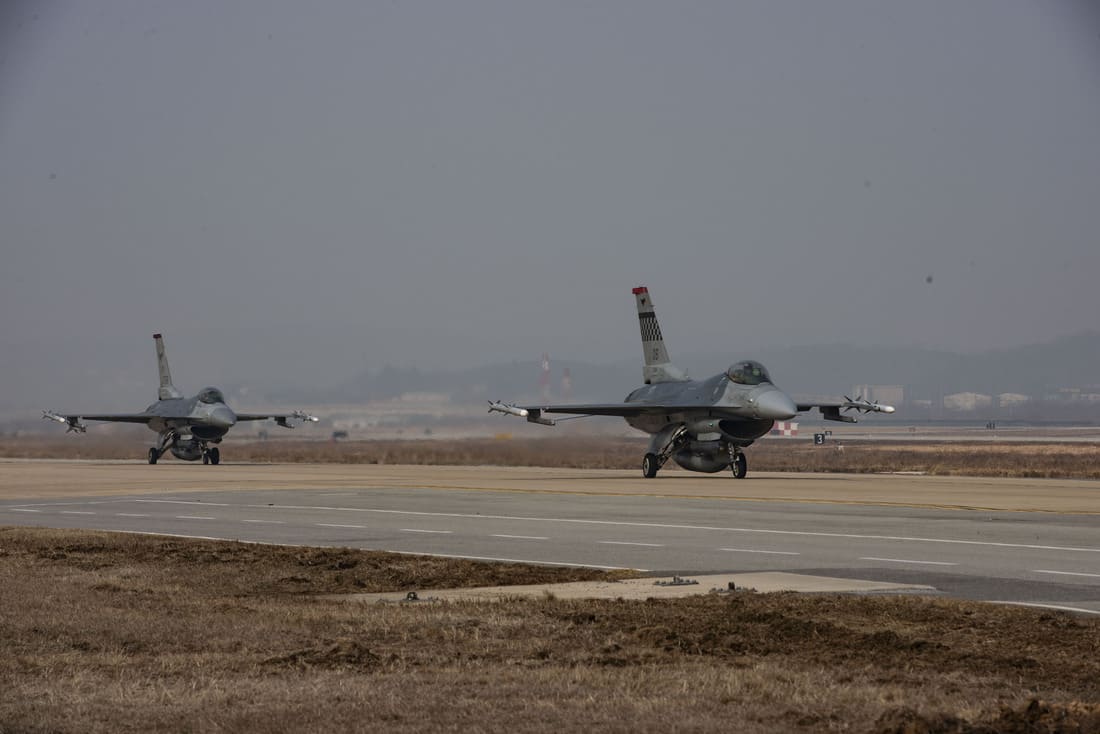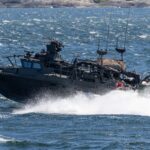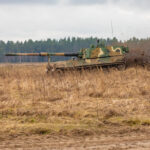The Air Force is transferring F-16s and personnel from Kunsan Air Base to Osan Air Base to form a second “super squadron” in South Korea. The service describes the transfer as temporary and tied to a defined year-two trial.
F-16 movement to Osan
Osan sits about 48 miles south of the Demilitarized Zone. Kunsan lies far to the southwest, near the Yellow Sea. The distance matters for alert timelines, logistics runs and sortie backlogs after weather or maintenance. The forward base hosts the Seventh Air Force and the 51st Fighter Wing which gives planners a direct chain for tasking and support.
Phase II adds roughly 31 F-16 Fighting Falcons and about 1,000 airmen to Osan by October 2025. The Air Force began ferry flights at the end of July and will complete the flow during the summer period to align with the second-phase start. Officials characterize the change as a time-bound test, not a permanent re-basing action. “Osan is receiving additional F-16s as part of the Air Force’s Super Squadron Test Part II initiative, which is a force-optimization test designed to see if a larger consolidated squadron can generate more combat power and operate more efficiently,” said Capt. Bryce Hughes of the 51st Maintenance Group.
The year-two plan follows a formal approval in April by the chief of staff of the Air Force.
What changes in Phase II
The super-squadron trial increases the number of aircraft and personnel that Osan’s 36th Fighter Squadron and 36th Fighter Generation Squadron support. Phase I, starting in October 2024, added nine F-16s and 150 airmen to test scheduling and sortie flow. Phase II raises the total to 31 aircraft for a longer period, measuring performance under varied conditions: avionics issues in heat, engine runs during peak power demand, weapons loading tempo in combined drills, and munitions handling with limited ramp space.
The wing expanded cross-training to limit skill gaps. Osan-based maintainers are working alongside the 36th Fighter Generation Squadron on F-16 tasks to broaden coverage and avoid single points of failure during deployments or leave. Senior Master Sgt. Jason Thomas said the approach puts multi-capable airman concepts into daily use. The goal is to keep sortie rates high with fewer shop-to-shop transfers, a target that will be tested once all aircraft are on station.
Phase II runs through October 2026, giving analysts two years of data across seasons, inspection cycles, and major exercises with the Republic of Korea Air Force. The length of the trial allows comparisons with Kunsan’s baseline numbers and with long-term averages at Osan before the test began. If the consolidated model delivers higher availability and quicker turn times without increasing deferred maintenance, the service will have a case for using it in other theaters.
“We’re working hand-in-hand with the Wolf Pack to ensure a smooth transition of both personnel and equipment in preparation for Phase II,” said Col. Ryan Ley, commander of the 51st Fighter Wing. “The 51st Fighter Wing is leading the charge on the Super Squadron Test. I’m proud of what the Mustangs have accomplished already, and I look forward to testing the limits of what we can do over the next year.” The wing will keep its “Fight Tonight” readiness posture through the trial, maintaining alert coverage and combined training.
Kunsan’s role during the trial and Seventh Air Force posture
Seventh Air Force directed the 8th Fighter Wing to keep flightline operations active, receive and house rotational forces, and maintain war-reserve materiel and munitions at multiple sites across South Korea.
When Phase II was approved in April, then-commander Col. Peter Kasarskis said the wing would meet the change with its established warfighter focus, while strengthening its ability to accept follow-on forces, defend the base and operate north. His statement reflected long standing 8th Fighter Wing priorities and its role in combined defense. In May, command passed to Col. Kathryn Gaetke with the mission set unchanged.
At Kunsan, the impact is felt in manpower and supply. The wing must replace certain specialties after personel move north and manage parts orders with fewer aircraft on site. Even so, the runway remains busy, live armament loads stay in place, and the exercise schedule continues. Freedom Flag and other bilateral drills still use Kunsan’s airspace, ranges, and ramp. Coordination with Osan is simpler when both wings share maintenace data and sortie plans during the test.
At Osan, the 51st Fighter Wing becomes the focal point. Added jets and maintainers increase demand on munitions storage, aerospace ground equipment and towing. Cross-qualification has begun so avionics and crew chiefs can work across aircraft blocks and configurations without delay, supporting surge operations and joint drills with the Republic of Korea Air Force.
What to watch through 2026
Defense officials confirm the chief of staff’s April approval set the conditions for Phase II and fixed the October 2025 start date. Seventh Air Force’s objective is clear: increase combat power through a larger, consolidated unit without trading away safety, readiness, or cost control. The two-year span allows commanders to adjust manning and processes as trends emerge.
According to industry sources, other commands are following the trial to see how Osan manages its second-year manning model and maintenance flow. They want to know whether a larger squadron keeps more aircraft mission-capable on a normal day, whether the shop structure can scale without bottlenecks, and whether spare parts pipelines keep pace when most of the fleet operates from one flightline. The results will influence how other bases approach consolidation.
The measures are specific:
- Sortie generation rate by week and by phase of flight, including scrub rates and weather recovery windows.
- Mission capable rate, cannibalization rate, and deferred discrepancy counts at both squadron and wing level.
A larger unit can mask short spikes in non-mission-capable time if only monthly averages are used. The trial will show whether the consolidated line can sustain daily operations, including the extended hours of bilateral drills. Leaders will also track cost per flying hour and maintenance man-hours per flying hour against historical baselines to determine if manpower savings offset the higher tempo at the consolidated base.
Training with the Republic of Korea Air Force is expected to increase. Osan’s location near ranges and joint headquarters reduces transit time, allowing more joint sorties and maintenance drills in a given week. Higher frequency should improve aircrew and maintainer proficiency in combat search and rescue, interdiction, and strike control. Whether ramp space, weapons handling capacity, and parking can keep up will be clear once the schedule tightens.
Col. Ley has signaled the wing will push the system hard. That includes tracking parts delays, downtime of aerospace ground equipment, and aircraft wash cycles during sustained operations. Any of these can limit availability if not managed. Cross-training within the maintenance group is intended to keep critical positions manned even during absences or surges.
REFERENCE SOURCES
- https://www.usfk.mil/Media/Newsroom/News/Article/4165913/seventh-air-force-to-extend-super-squadron-test-for-second-year-expand-scope/
- https://www.af.mil/News/Article-Display/Article/4260525/f-16s-relocate-to-osan-ab-as-super-squadron-test-prepares-to-enter-phase-ii/
- https://www.af.mil/News/Article-Display/Article/4165213/seventh-air-force-to-extend-super-squadron-test-for-second-year-expand-scope/
- https://www.kunsan.af.mil/-Wolf-Pack-News/Display/Article/4260446/wolf-packs-f-16-fighting-falcons-begin-departure-for-super-squadron-test-phase/
- https://www.stripes.com/branches/air_force/2025-08-01/f16-super-squadron-south-korea-18632502.html
- https://www.airforcetimes.com/news/your-air-force/2025/08/06/air-force-moves-f-16s-closer-to-north-korea-in-new-super-squadron/
- https://www.airandspaceforces.com/osan-f-16-second-super-squadron/



